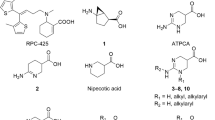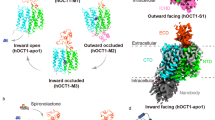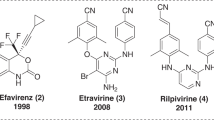Abstract
The human equilibrative nucleoside transporter 1 (hENT1), a member of the SLC29 family, plays crucial roles in adenosine signaling, cellular uptake of nucleoside for DNA and RNA synthesis, and nucleoside-derived anticancer and antiviral drug transport in humans. Because of its central role in adenosine signaling, it is the target of adenosine reuptake inhibitors (AdoRI), several of which are used clinically. Despite its importance in human physiology and pharmacology, the molecular basis of hENT1-mediated adenosine transport and its inhibition by AdoRIs are limited, owing to the absence of structural information on hENT1. Here, we present crystal structures of hENT1 in complex with two chemically distinct AdoRIs: dilazep and S-(4-nitrobenzyl)-6-thioinosine (NBMPR). Combined with mutagenesis study, our structural analyses elucidate two distinct inhibitory mechanisms exhibited on hENT1 and provide insight into adenosine recognition and transport. Our studies provide a platform for improved pharmacological intervention of adenosine and nucleoside analog drug transport by hENT1.
This is a preview of subscription content, access via your institution
Access options
Access Nature and 54 other Nature Portfolio journals
Get Nature+, our best-value online-access subscription
$29.99 / 30 days
cancel any time
Subscribe to this journal
Receive 12 print issues and online access
$189.00 per year
only $15.75 per issue
Buy this article
- Purchase on Springer Link
- Instant access to full article PDF
Prices may be subject to local taxes which are calculated during checkout





Similar content being viewed by others
Data availability
Atomic coordinates and structure factors for the reported crystal structures are deposited in the Protein Data Bank under accession codes PDB 6OB6 (hENT1 in complex with NBPMR) and PDB 6OB7 (hENT1 in complex with dilazep). Source data for Figs. 1a, 4b–d and Supplementary Figure 1 are available with the paper online. Any other data pertaining to this paper are available upon reasonable request to S.-Y.L.
References
Young, J. D., Yao, S. Y. M., Sun, L., Cass, C. E. & Baldwin, S. A. Human equilibrative nucleoside transporter (ENT) family of nucleoside and nucleobase transporter proteins. Xenobiotica 38, 995–1021 (2008).
Boswell-Casteel, R. C. & Hays, F. A. Equilibrative nucleoside transporters—A review. Nucleosides Nucleotides Nucleic Acids 36, 7–30 (2017).
Griffiths, M. et al. Cloning of a human nucleoside transporter implicated in the cellular uptake of adenosine and chemotherapeutic drugs. Nat. Med. 3, 89–93 (1997).
Molina-Arcas, M., Casado, F. J. & Pastor-Anglada, M. Nucleoside transporter proteins. Curr. Vasc. Pharmacol. 7, 426–434 (2009).
Borea, P. A., Gessi, S., Merighi, S. & Varani, K. Adenosine as a multi-signalling guardian angel in human diseases: when, where and how does it exert its protective effects? Trends Pharmacol. Sci. 37, 419–434 (2016).
Mubagwa, K. & Flameng, W. Adenosine, adenosine receptors and myocardial protection: an updated overview. Cardiovasc. Res. 52, 25–39 (2001).
Choi, D. S. et al. The type 1 equilibrative nucleoside transporter regulates ethanol intoxication and preference. Nat. Neurosci. 7, 855–861 (2004).
Baldwin, S. A., Mackey, J. R., Cass, C. E. & Young, J. D. Nucleoside transporters: molecular biology and implications for therapeutic development. Mol. Med. Today 5, 216–224 (1999).
Young, J. D., Yao, S. Y., Baldwin, J. M., Cass, C. E. & Baldwin, S. A. The human concentrative and equilibrative nucleoside transporter families, SLC28 and SLC29. Mol. Aspects Med. 34, 529–547 (2013).
Yoshida, H. et al. Effects of an anti-platelet drug (dilazep) in IgA nephropathy: comparison of clinical effects with renal biopsy findings. Nihon Jinzo Gakkai Shi 36, 339–344 (1994).
Fitzgerald, G. Drug therapy: dipyridamole. N. Engl. J. Med. 316, 1247–1257 (1987).
Guo, Z. et al. Rapamycin-inspired macrocycles with new target specificity. Nat. Chem. 11, 254–263 (2019).
Buolamwini, J. Nucleoside transport inhibitors: structure activity relationships and potential therapeutic applications. Curr. Med. Chem. 4, 35–66 (1996).
Lin, W. & Buolamwini, J. K. Synthesis, flow cytometric evaluation, and identification of highly potent dipyridamole analogues as equilibrative nucleoside transporter 1 inhibitors. J. Med. Chem. 50, 3906–3920 (2007).
Gupte, A. & Buolamwini, J. K. CoMFA and CoMSIA 3D-QSAR studies on S6-(4-nitrobenzyl)mercaptopurine riboside (NBMPR) analogs as inhibitors of human equilibrative nucleoside transporter 1 (hENT1). Bioorg. Med. Chem. Lett. 19, 314–318 (2009).
Farrell, J. J. et al. Human equilibrative nucleoside transporter 1 levels predict response to gemcitabine in patients with pancreatic cancer. Gastroenterology 136, 187–195 (2009).
Greenhalf, W. et al. Pancreatic cancer hENT1 expression and survival from gemcitabine in patients from the ESPAC-3 trial. J. Natl. Cancer Inst. 106, djt347 (2014).
Hagmann, W., Jesnowski, R. & Löhr, J. M. Interdependence of gemcitabine treatment, transporter expression, and resistance in human pancreatic carcinoma cells. Neoplasia 12, 740–747 (2010).
Marcé, S. et al. Expression of human equilibrative nucleoside transporter 1 (hENT1) and its correlation with gemcitabine uptake and cytotoxicity in mantle cell lymphoma. Haematologica 91, 895–902 (2006).
Marechal, R. et al. Human equilibrative nucleoside transporter 1 and human concentrative nucleoside transporter 3 predict survival after adjuvant gemcitabine therapy in resected pancreatic adenocarcinoma. Clin. Cancer Res. 15, 2913–2919 (2009).
Spratlin, J. et al. The absence of human equilibrative nucleoside transporter 1 is associated with reduced survival in patients with gemcitabine-treated pancreas adenocarcinoma. Clin. Cancer Res. 10, 6956–6961 (2004).
Tanaka, M. et al. Gemcitabine metabolic and transporter gene polymorphisms are associated with drug toxicity and efficacy in patients with locally advanced pancreatic cancer. Cancer 116, 5325–5335 (2010).
Voutsadakis, I. A. Molecular predictors of gemcitabine response in pancreatic cancer. World J. Gastrointest. Oncol. 3, 153–164 (2011).
Johnson, Z. L., Cheong, C. G. & Lee, S. Y. Crystal structure of a concentrative nucleoside transporter from Vibrio cholerae at 2.4A. Nature 483, 489–493 (2012).
Johnson, Z. L. et al. Structural basis of nucleoside and nucleoside drug selectivity by concentrative nucleoside transporters. eLife 3, e03604 (2014).
Hirschi, M., Johnson, Z. L. & Lee, S.-Y. Visualizing multistep elevator-like transitions of a nucleoside transporter. Nature 545, 66–70 (2017).
Aseervatham, J., Tran, L., Machaca, K. & Boudker, O. The role of flexible loops in folding, trafficking and activity of equilibrative nucleoside transporters. PloS One 10, e0136779 (2015).
Huang, W., Zeng, X., Shi, Y. & Liu, M. Functional characterization of human equilibrative nucleoside transporter 1. Protein Cell 8, 284–295 (2017).
Sundaram, M. et al. Topology of a human equilibrative, nitrobenzylthioinosine (nbmpr)-sensitive nucleoside transporter (hENT1) implicated in the cellular uptake of adenosine and anti-cancer drugs. J. Biol. Chem. 276, 45270–45275 (2001).
Deng, D. et al. Molecular basis of ligand recognition and transport by glucose transporters. Nature 526, 391–396 (2015).
Abramson, J. et al. Structure and mechanism of the lactose permease of Escherichia coli. Science 301, 610–615 (2003).
Jarvis, S. M., McBride, D. & Young, J. D. Erythrocyte nucleoside transport: asymmetrical binding of nitrobenzylthioinosine to nucleoside permeation sites. J. Physiol. 324, 31–46 (1982).
Jarvis, S. M. & Young, J. D. Nucleoside transport in rat erythrocytes: two components with differences in sensitivity to inhibition by nitrobenzylthioinosine and p-chloromercuriphenyl sulfonate. J. Membr. Biol. 93, 1–10 (1986).
Agbanyo, F. R., Cass, C. E. & Paterson, A. R. External location of sites on pig erythrocyte membranes that bind nitrobenzylthioinosine. Mol. Pharmacol. 33, 332–337 (1988).
Yao, S. Y. M., Ng, A. M. L., Cass, C. E. & Young, J. D. Role of cysteine 416 in N-ethylmaleimide sensitivity of human equilibrative nucleoside transporter 1 (hENT1). Biochem. J. 475, 3293–3309 (2018).
Zhang, X. C., Zhao, Y., Heng, J. & Jiang, D. Energy coupling mechanisms of MFS transporters. Protein Sci. 24, 1560–1579 (2015).
Paproski, RobertJ. et al. Mutation of Trp 29 of human equilibrative nucleoside transporter 1 alters affinity for coronary vasodilator drugs and nucleoside selectivity. Biochem. J. 414, 291–300 (2008).
Endres, C. J. & Unadkat, J. D. Residues Met89 and Ser160 in the human equilibrative nucleoside transporter 1 affect its affinity for adenosine, guanosine, S6-(4-nitrobenzyl)-mercaptopurine riboside, and dipyridamole. Mol. Pharmacol. 67, 837–844 (2005).
Endres, C. J., Sengupta, D. J. & Unadkat, J. D. Mutation of leucine-92 selectively reduces the apparent affinity of inosine, guanosine, NBMPR [S6-(4-nitrobenzyl)-mercaptopurine riboside] and dilazep for the human equilibrative nucleoside transporter, hENT1. Biochem. J. 380, 131–137 (2004).
SenGupta, D. J. & Unadkat, J. D. Glycine 154 of the equilibrative nucleoside transporter, hENT1, is important for nucleoside transport and for conferring sensitivity to the inhibitors nitrobenzylthioinosine, dipyridamole, and dilazep. Biochem. Pharmacol. 67, 453–458 (2004).
Arastu-Kapur, S., Ford, E., Ullman, B. & Carter, N. S. Functional analysis of an inosine-guanosine transporter from Leishmania donovani. The role of conserved residues, aspartate 389 and arginine 393. J. Biol. Chem. 278, 33327–33333 (2003).
Visser, F. et al. Mutation of residue 33 of human equilibrative nucleoside transporters 1 and 2 alters sensitivity to inhibition of transport by dilazep and dipyridamole. J. Biol. Chem. 277, 395–401 (2002).
Visser, F., Baldwin, S. A., Isaac, R. E., Young, J. D. & Cass, C. E. Identification and mutational analysis of amino acid residues involved in dipyridamole interactions with human and caenorhabditis elegans equilibrative nucleoside transporters. J. Biol. Chem. 280, 11025–11034 (2005).
Visser, F. et al. Residues 334 and 338 in transmembrane segment 8 of human equilibrative nucleoside transporter 1 are important determinants of inhibitor sensitivity, protein folding, and catalytic turnover. J. Biol. Chem. 282, 14148–14157 (2007).
Visser, F. et al. Residue 33 of human equilibrative nucleoside transporter 2 is a functionally important component of both the dipyridamole and nucleoside binding sites. Mol. Pharmacol. 67, 1291–1298 (2005).
Quistgaard, E. M., Löw, C., Guettou, F. & Nordlund, P. Understanding transport by the major facilitator superfamily (MFS): structures pave the way. Nat. Rev. Mol. Cell Biol. 17, 123–132 (2016).
Deng, D. et al. Crystal structure of the human glucose transporter GLUT1. Nature 510, 121–125 (2014).
Krishnamurthy, H. & Gouaux, E. X-ray structures of LeuT in substrate-free outward-open and apo inward-open states. Nature 481, 469–474 (2012).
Penmatsa, A., Wang, K. H. & Gouaux, E. X-ray structure of dopamine transporter elucidates antidepressant mechanism. Nature 503, 85–90 (2013).
Coleman, J. A., Green, E. M. & Gouaux, E. X-ray structures and mechanism of the human serotonin transporter. Nature 532, 334–339 (2016).
Nomura, N. et al. Structure and mechanism of the mammalian fructose transporter GLUT5. Nature 526, 397–401 (2015).
Singh, S. K., Piscitelli, C. L., Yamashita, A. & Gouaux, E. A competitive inhibitor traps LeuT in an open-to-out conformation. Science 322, 1655–1661 (2008).
Kawate, T. & Gouaux, E. Fluorescence-detection size-exclusion chromatography for precrystallization screening of integral membrane proteins. Structure 14, 673–681 (2006).
Goehring, A. et al. Screening and large-scale expression of membrane proteins in mammalian cells for structural studies. Nat. Protoc. 9, 2574–2585 (2014).
Landau, E. M. & Rosenbusch, J. P. Lipidic cubic phases: A novel concept for the crystallization of membrane proteins. Proc. Natl Acad. Sci. USA 93, 14532–14535 (1996).
Li, D., Pye, V. E. & Caffrey, M. Experimental phasing for structure determination using membrane-protein crystals grown by the lipid cubic phase method. Acta Crystallogr. D Biol. Crystallogr. 71, 104–122 (2015).
Battye, T. G., Kontogiannis, L., Johnson, O., Powell, H. R. & Leslie, A. G. iMOSFLM: a new graphical interface for diffraction-image processing with MOSFLM. Acta Crystallogr. D Biol. Crystallogr. 67, 271–281 (2011).
Schneider, T. R. & Sheldrick, G. M. Substructure solution with SHELXD. Acta Crystallogr. D Biol. Crystallogr. 58, 1772–1779 (2002).
Adams, P. D. et al. PHENIX: a comprehensive Python-based system for macromolecular structure solution. Acta Crystallogr. D Biol. Crystallogr. 66, 213–221 (2010).
Kabsch, W. Xds. Acta Crystallogr. D Biol. Crystallogr. 66, 125–132 (2010).
Murshudov, G. N. et al. REFMAC5 for the refinement of macromolecular crystal structures. Acta Crystallogr. D Biol. Crystallogr. 67, 355–367 (2011).
Johnson, Z. L. & Lee, S. Y. Liposome reconstitution and transport assay for recombinant transporters. Methods Enzymol. 556, 373–383 (2015).
Acknowledgements
Data were collected at beamline 24-ID-C in the Advanced Photon Source. We thank A. Kuk for help with X-ray crystallography and critical manuscript reading and Y. Ying for help with membrane protein biochemistry. This work was supported by NIH R35 NS097241 (S.-Y.L.). Beamline 24-ID-C is funded by P41GM103403 and S10 RR029205.
Author information
Authors and Affiliations
Contributions
N.J.W. solved the structures and performed all experiments under the guidance of S.-Y.L. N.J.W. and S.-Y.L. wrote the paper.
Corresponding author
Ethics declarations
Competing interests
The authors declare no competing interests.
Additional information
Peer review information: Katarzyna Marcinkiewicz was the primary editor on this article and managed its editorial process and peer review in collaboration with the rest of the editorial team.
Publisher’s note: Springer Nature remains neutral with regard to jurisdictional claims in published maps and institutional affiliations.
Integrated supplementary information
Supplementary Figure 1 Human ENT1 nucleoside transport assay.
Human ENT1 reconstituted vesides loaded with 1.0 mM cold uridine mediate uptake of 3H-uridine, with transport sensitive to addition of 1.0 μM NBMPR. Experiments performed in n = 11 technical replicates from three independent vesicle preps, with error bars representing ± S.E.M. (**p ≤ 0.01, ****p ≤ 0.0001, unpaired two-tailed t-test).
Supplementary Figure 2 Experimental phasing and structure determination of dilazep-bound hENT1cryst.
a, Stereo view of the final model in the initial density modified SIRAS map (1σ) to 3.5 Å. b, Stereo view of the final model in 2Fo-Fc composite omit calculated map (1σ), to 2.3 Å. c, Protein cross-section view of dilazep binding site, final model in 2Fo-Fc composite omit calculated map (1σ), to 2.3 Å. d, Fo-Fc simulated annealing omit map (3σ) to 2.3 Å, calculated using a starting temperature of 2,500K.
Supplementary Figure 3 Density maps for NBMPR bound hENT1cryst.
Stereo view of final 2Fo-Fc maps for NBMPR bound hENT1cryst (1σ). All maps calculated with anisotropically corrected X-ray data to 2.9 Å. b, Protein cross-section view of final 2Fo-Fc maps for NBMPR bound hENT1cryst (1σ). c, NBMPR Fo-Fc simple omit map (2σ). d, NBMPR Fo-Fc simulated annealing omit map (2σ), calculated using a starting temperature of 2,500K.
Supplementary Figure 4 Pseudo-symmetry and comparison to the MFS fold.
Structural superposition of the two symmetry related domains of hENT1cryst. The domains align with a Cα R.M.S.D. of 4.0 Å b, Structural superposition of hENT1cryst and a representative outward-facing MFS transporter, human Glut 3 (PDB ID: 4ZW9) c, An interaction network present between the N and C domains of hENT1cryst is distinct from the MFS gating A-motif, as depicted by the representative MFS human Glut3 (PDB ID 4ZW9).
Supplementary Figure 5 Mapping of previous functional studies.
a, Human ENT1 residues previously implicated in dilazep sensitivity, NBMPR and/or nucleoside recognition mapped to the dilazep bound (left) and NBMPR bound (right) human ENT1cyst structures. b, Structural basis for the high level of human ENT1 isoform specificity exhibited by NBMPR. Comparison of the central cavity from NBMPR bound hENT1cryst (left) with the mutation G154S modelled into this structure (right), highlighting the requirement of glycine at hENT1 position 154 for NBMPR binding. This equivalent position in hENT2 and hENT3 (both NBMPR insensitive) features a serine.
Supplementary information
Supplementary Information
Supplementary Figures 1–5 and Supplementary Note 1
Source data figures and tables
Rights and permissions
About this article
Cite this article
Wright, N.J., Lee, SY. Structures of human ENT1 in complex with adenosine reuptake inhibitors. Nat Struct Mol Biol 26, 599–606 (2019). https://doi.org/10.1038/s41594-019-0245-7
Received:
Accepted:
Published:
Issue Date:
DOI: https://doi.org/10.1038/s41594-019-0245-7
This article is cited by
-
Antiviral drug recognition and elevator-type transport motions of CNT3
Nature Chemical Biology (2024)
-
Kinetic profiling of novel spirobenzo-oxazinepiperidinone derivatives as equilibrative nucleoside transporter 1 inhibitors
Purinergic Signalling (2024)
-
Membrane transporters in drug development and as determinants of precision medicine
Nature Reviews Drug Discovery (2024)
-
Structural basis of the substrate recognition and inhibition mechanism of Plasmodium falciparum nucleoside transporter PfENT1
Nature Communications (2023)
-
Molecular basis of polyspecific drug and xenobiotic recognition by OCT1 and OCT2
Nature Structural & Molecular Biology (2023)



